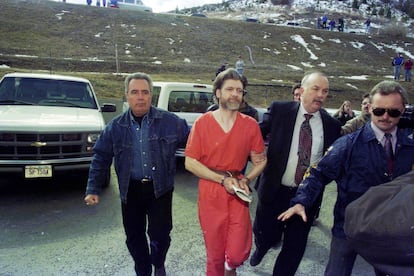Why the Unabomber’s ideas continue to resonate across the political spectrum: From Musk to Mangione
It’s been 30 years since the American terrorist was arrested and a year and a half since he killed himself in prison

Carlos, a 27-year-old from Spain, like most of his generation, often resorts to scrolling through various social networks when he gets bored. YouTube, TikTok, Instagram, X... Before long, a post he has already seen appears. It’s a screenshot from an app with the message: “Respond to more fans with your own AI. Create an AI to answer questions, share links, and connect with your fans without having to accept message requests.” In the background, there is an image of a bearded, scruffy, and stern-looking man. Carlos shares the post with several ideologically opposed acquaintances, who laugh or comment that he is right. That man is Theodore “Ted” J. Kaczynski, the American terrorist widely known as the “Unabomber.”
Of all the corners of social media and its various fads, few are more extravagant than the posts about Kaczynski. Photos and videos with catchy, pounding music show his ramshackle shelter, his homemade bombs, passages from his manifesto, his police record, and his identikit. There are profiles that encourage people to take the “Ted-pill,” a reference to The Matrix, in which the protagonist Neo escapes from his mental-dream prison after ingesting a red pill. In this case, the pill symbolizes rejecting the industrial world and its consequences. As Baudelaire wrote, man advances through forest-groves of symbols, strange and solemn, who follow him with their familiar glances.
A Harvard graduate at a young age, Kaczynski completed his PhD in mathematics at the University of Michigan. His thesis was so complex that only 10 or 12 people in the United States are said to understand it. Later, he became an adjunct professor at Berkeley but resigned after just two years to isolate himself in a cabin with no running water, gas, or electricity — just 13 square meters in the woods of Montana, in the style of Henry David Thoreau or Ralph Waldo Emerson.
From there, he targeted academics and businessmen, and indiscriminately attacked civilians with homemade explosives between 1978 and 1995. He killed three people and wounded 23 others in an effort to hasten the collapse of industrial society. His mail bombs made opening the mail a source of nervousness for many Americans. In 1995, he proposed to abandon violence if a national newspaper would publish a manifesto — more than 25,000 words long — outlining how the social and industrial foundations of the economic system had led to an era of suffering and environmental destruction.
The Attorney General pushed for it, and The New York Times and The Washington Post published it. Ted’s big mistake was flying too close to the sun. His brother, David, recognized his ideas and literary style and alerted the authorities, who, after a linguistic analysis, confirmed his identity. Throughout its campaign to find the Unabomber, the FBI spent over $50 million (its total budget that year was $2.24 billion) and was only able to arrest him thanks to letters provided by his brother. The devil is in the details.
Kaczynski faced a trial in which he was denied the right to represent himself, despite facing the death penalty. He pleaded guilty to the charges, and his sentence was commuted to four life terms. David received a million dollars as a reward — his thirty pieces of silver.
In 1998, Kaczynski was imprisoned in the maximum-security ADX Florence in Colorado, trading his 13-square-meter cabin for a seven-square-meter cell. He shared the prison with founding members of Al-Qaeda, the masterminds of 9/11, Soviet spies, and Joaquín “El Chapo” Guzmán, among others — the best of each house of villains. In 2021, he was transferred to a prison medical facility, where on June 10, 2023, he killed himself.
Since his death, his reputation has been on the rise, bolstered by several series and films about his life aired by giants like Netflix and Discovery Channel. His manifesto Industrial Society and Its Future — freely available and in the public domain — remains one of the best-selling books on Amazon in the radical thought category. The FBI even moved his cabin to its headquarters in the summer of 2020 after it became a pilgrimage site. In June of this past year, Maxim Loskutoff’s book Old King, about Kaczynski, was selected as one of the best books of the year by Publisher’s Weekly.
If the German philosopher Max Müller was right when he argued that, both in modern times and in Homer’s era, we live in the shadow of myths — we just don’t recognize them — Ted Kaczynski can be considered one of these myths. Initially influential among many in radical environmental movements for his technophobic views, Kaczynski’s vehement criticism of “leftism” has recently gained traction within far-right circles.
The Norwegian terrorist Anders Breivik, who killed 77 people and injured over 300, plagiarized large portions of Kaczynski’s manifesto. In 2018, the Greek neo-Nazi party Golden Dawn translated his work. A now-deleted audiobook was created by Augustus Invictus, a notorious American white supremacist. Elon Musk tweeted that Kaczynski “might not be wrong,” and the controversial U.S. commentator Tucker Carlson remarked, “bad person, but a smart analysis.” Luigi Mangione, the alleged killer of UnitedHealthcare CEO Brian Thompson on December 4, posted a review on Goodreads of Kaczynski’s manifesto which stated: “‘Violence never solved anything’ is a phrase uttered by cowards and predators.”
Industrial Rule
by u/LukeSunner66 in 196
The figure of the extremist has been mythologized by a disturbingly diverse range of political profiles: anarcho-primitivists, eco-fascists, orthodox Marxists, conservatives… Each, with their own inconsistencies, selectively embraces and idealizes the figure and ideas of Kaczynski. Like the profiles on social media networks, they romanticize a return to a pre-industrial way of life, driven by a dystopian diagnosis of the present and its future. Paradoxically, they use digital media with millions of followers to spread an anti-technological political philosophy.
Carlos, the young Spaniard, will continue to wander through social networks and will come across another post about Kaczynski, this time about advertising in the sky. And this time, he will be the one to claim that Kaczynski was right. In Baudelaire’s forest, symbols both welcome and shelter, but they also entangle. One must stay alert, even if it’s a forest in Montana.
Sign up for our weekly newsletter to get more English-language news coverage from EL PAÍS USA Edition
Tu suscripción se está usando en otro dispositivo
¿Quieres añadir otro usuario a tu suscripción?
Si continúas leyendo en este dispositivo, no se podrá leer en el otro.
FlechaTu suscripción se está usando en otro dispositivo y solo puedes acceder a EL PAÍS desde un dispositivo a la vez.
Si quieres compartir tu cuenta, cambia tu suscripción a la modalidad Premium, así podrás añadir otro usuario. Cada uno accederá con su propia cuenta de email, lo que os permitirá personalizar vuestra experiencia en EL PAÍS.
¿Tienes una suscripción de empresa? Accede aquí para contratar más cuentas.
En el caso de no saber quién está usando tu cuenta, te recomendamos cambiar tu contraseña aquí.
Si decides continuar compartiendo tu cuenta, este mensaje se mostrará en tu dispositivo y en el de la otra persona que está usando tu cuenta de forma indefinida, afectando a tu experiencia de lectura. Puedes consultar aquí los términos y condiciones de la suscripción digital.
More information
Archived In
Últimas noticias
All the effects of gentrification in one corner of Mexico’s Colonia Roma
Palestinian reporter Youmna El Sayed: ‘My family told me I had to choose between being a journalist or a mother’
‘Sleepless City’: The light of cinema illuminates Madrid’s Cañada Real shantytown
The new language of the workplace: Knowing how to ask AI questions is more important than using it
Most viewed
- The low-cost creative revolution: How technology is making art accessible to everyone
- Christian Louboutin: ‘Young people don’t want to be like their parents. And if their parents wear sneakers, they’re going to look for something else’
- US sanctions against jailed cartel leader ‘El Marro’ highlight Mexico’s lack of control over its prisons
- Liset Menéndez de la Prida, neuroscientist: ‘It’s not normal to constantly seek pleasure; it’s important to be bored, to be calm’
- ‘El Limones’ and the growing union disguise of Mexican organized crime










































